7HR02: Resourcing and Talent Management Report Analysis
VerifiedAdded on 2023/06/07
|19
|6472
|102
Report
AI Summary
This report provides a comprehensive analysis of resourcing and talent management strategies, focusing on the Darwish Group, a Qatar-based retailing organization. The report begins with an email to the CEO, critically analyzing the impact of the changing business environment, including workforce diversity, technological changes, and work flexibility, on resourcing and talent management. It discusses the significance of these changes for the organization, such as improved employee satisfaction and efficiency. The report then explores potential future developments in the field, including work-life balance, employee feedback, virtual environments, and employee development. Task 2 delves into job analysis, competency frameworks, and job design, evaluating effective recruitment, selection, and induction methods. The report further analyzes talent planning and retention strategies, including the use of analytics and measures to reduce employee turnover. Finally, it critically evaluates the use of technology for performance monitoring, considering ethical debates. The report provides an overview of current trends and future developments in the field of resourcing and talent management.
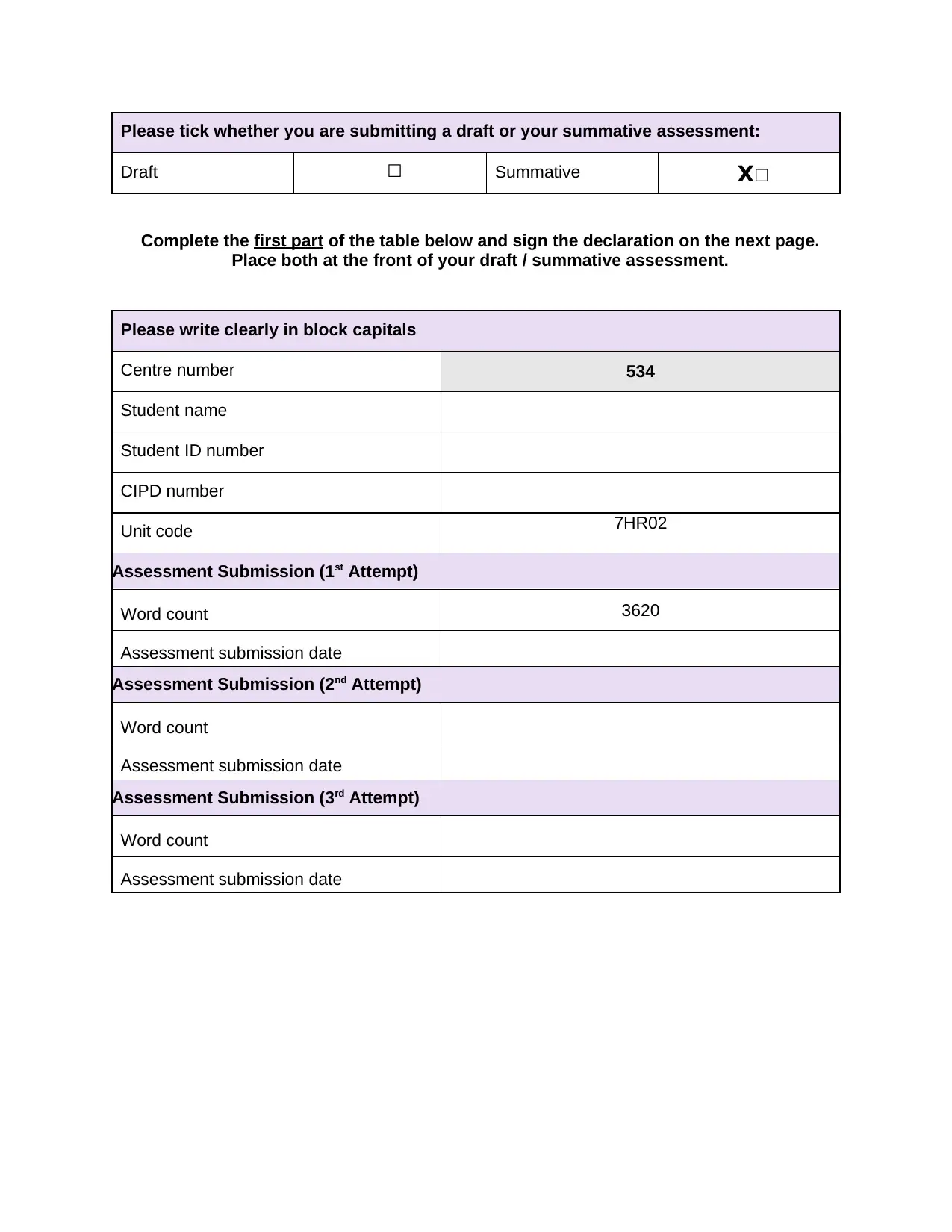
Please tick whether you are submitting a draft or your summative assessment:
Draft ☐ Summative X☐
Complete the first part of the table below and sign the declaration on the next page.
Place both at the front of your draft / summative assessment.
Please write clearly in block capitals
Centre number 534
Student name
Student ID number
CIPD number
Unit code 7HR02
Assessment Submission (1st Attempt)
Word count 3620
Assessment submission date
Assessment Submission (2nd Attempt)
Word count
Assessment submission date
Assessment Submission (3rd Attempt)
Word count
Assessment submission date
Draft ☐ Summative X☐
Complete the first part of the table below and sign the declaration on the next page.
Place both at the front of your draft / summative assessment.
Please write clearly in block capitals
Centre number 534
Student name
Student ID number
CIPD number
Unit code 7HR02
Assessment Submission (1st Attempt)
Word count 3620
Assessment submission date
Assessment Submission (2nd Attempt)
Word count
Assessment submission date
Assessment Submission (3rd Attempt)
Word count
Assessment submission date
Paraphrase This Document
Need a fresh take? Get an instant paraphrase of this document with our AI Paraphraser

Declaration By Learner (student to complete):
I can confirm that this assessment is all my own work and where I have used materials
from other sources, they have been properly acknowledged.
Student Name
Student Signature
Date
Declaration By Assessor (marker to complete):
I confirm that:
The learner’s work was conducted under the conditions laid out by the
assessment brief.
I am satisfied that to the best of my knowledge, the work produced is solely that of
the learner.
Assessor Name
Assessor Signature
Date
IQA Name
IQA Signature
Date
I can confirm that this assessment is all my own work and where I have used materials
from other sources, they have been properly acknowledged.
Student Name
Student Signature
Date
Declaration By Assessor (marker to complete):
I confirm that:
The learner’s work was conducted under the conditions laid out by the
assessment brief.
I am satisfied that to the best of my knowledge, the work produced is solely that of
the learner.
Assessor Name
Assessor Signature
Date
IQA Name
IQA Signature
Date
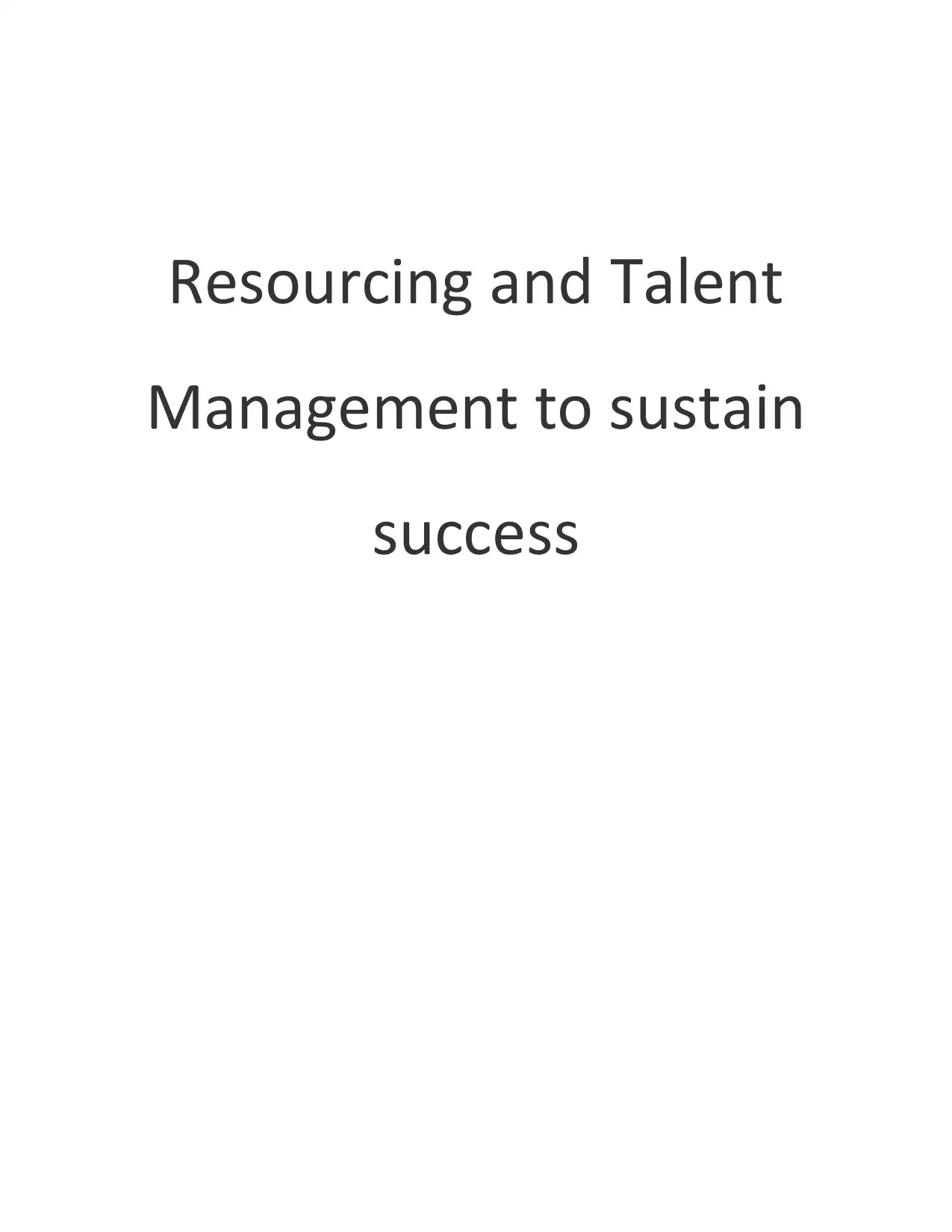
Resourcing and alentT
Management to sustain
success
Management to sustain
success
⊘ This is a preview!⊘
Do you want full access?
Subscribe today to unlock all pages.

Trusted by 1+ million students worldwide
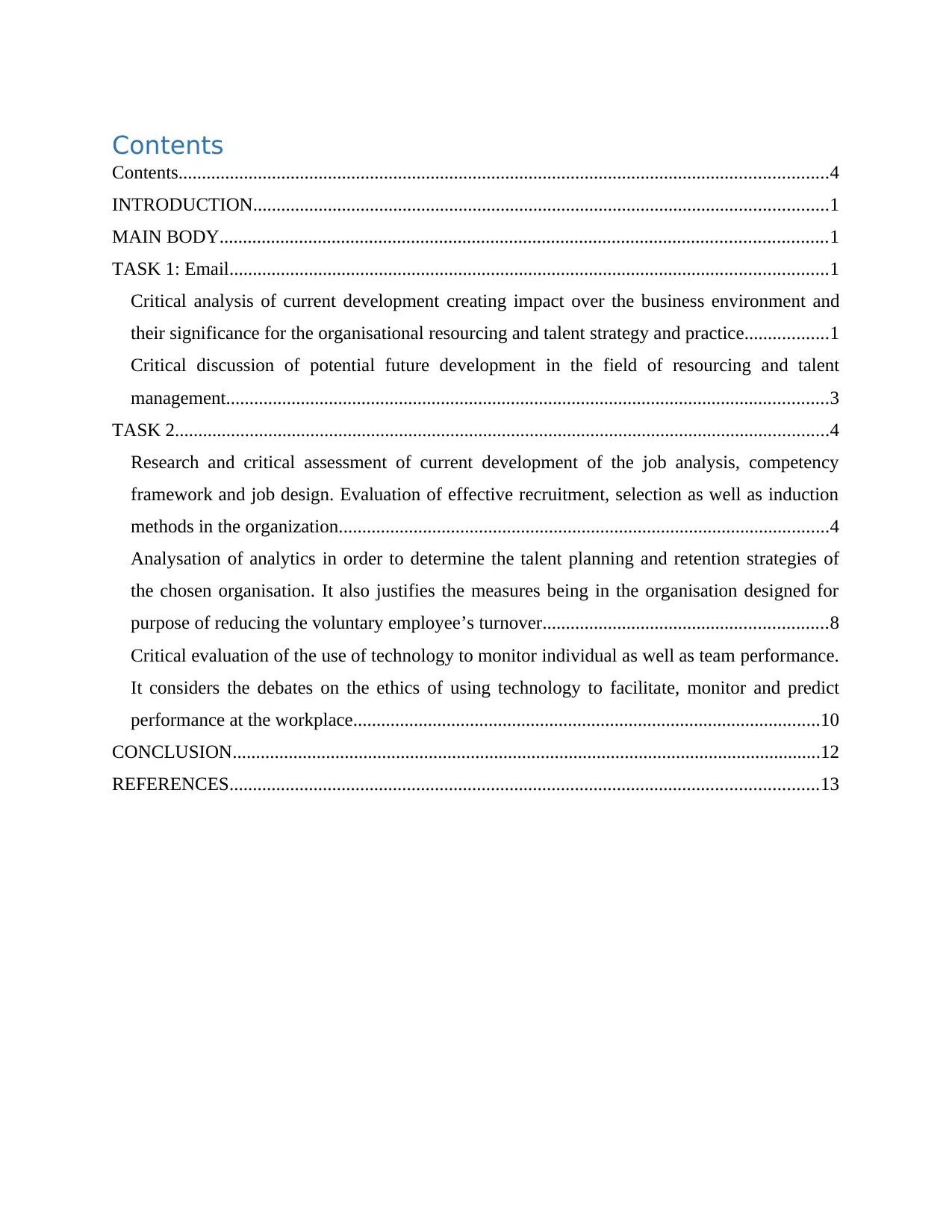
Contents
Contents...........................................................................................................................................4
INTRODUCTION...........................................................................................................................1
MAIN BODY..................................................................................................................................1
TASK 1: Email................................................................................................................................1
Critical analysis of current development creating impact over the business environment and
their significance for the organisational resourcing and talent strategy and practice..................1
Critical discussion of potential future development in the field of resourcing and talent
management.................................................................................................................................3
TASK 2............................................................................................................................................4
Research and critical assessment of current development of the job analysis, competency
framework and job design. Evaluation of effective recruitment, selection as well as induction
methods in the organization.........................................................................................................4
Analysation of analytics in order to determine the talent planning and retention strategies of
the chosen organisation. It also justifies the measures being in the organisation designed for
purpose of reducing the voluntary employee’s turnover.............................................................8
Critical evaluation of the use of technology to monitor individual as well as team performance.
It considers the debates on the ethics of using technology to facilitate, monitor and predict
performance at the workplace....................................................................................................10
CONCLUSION..............................................................................................................................12
REFERENCES..............................................................................................................................13
Contents...........................................................................................................................................4
INTRODUCTION...........................................................................................................................1
MAIN BODY..................................................................................................................................1
TASK 1: Email................................................................................................................................1
Critical analysis of current development creating impact over the business environment and
their significance for the organisational resourcing and talent strategy and practice..................1
Critical discussion of potential future development in the field of resourcing and talent
management.................................................................................................................................3
TASK 2............................................................................................................................................4
Research and critical assessment of current development of the job analysis, competency
framework and job design. Evaluation of effective recruitment, selection as well as induction
methods in the organization.........................................................................................................4
Analysation of analytics in order to determine the talent planning and retention strategies of
the chosen organisation. It also justifies the measures being in the organisation designed for
purpose of reducing the voluntary employee’s turnover.............................................................8
Critical evaluation of the use of technology to monitor individual as well as team performance.
It considers the debates on the ethics of using technology to facilitate, monitor and predict
performance at the workplace....................................................................................................10
CONCLUSION..............................................................................................................................12
REFERENCES..............................................................................................................................13
Paraphrase This Document
Need a fresh take? Get an instant paraphrase of this document with our AI Paraphraser

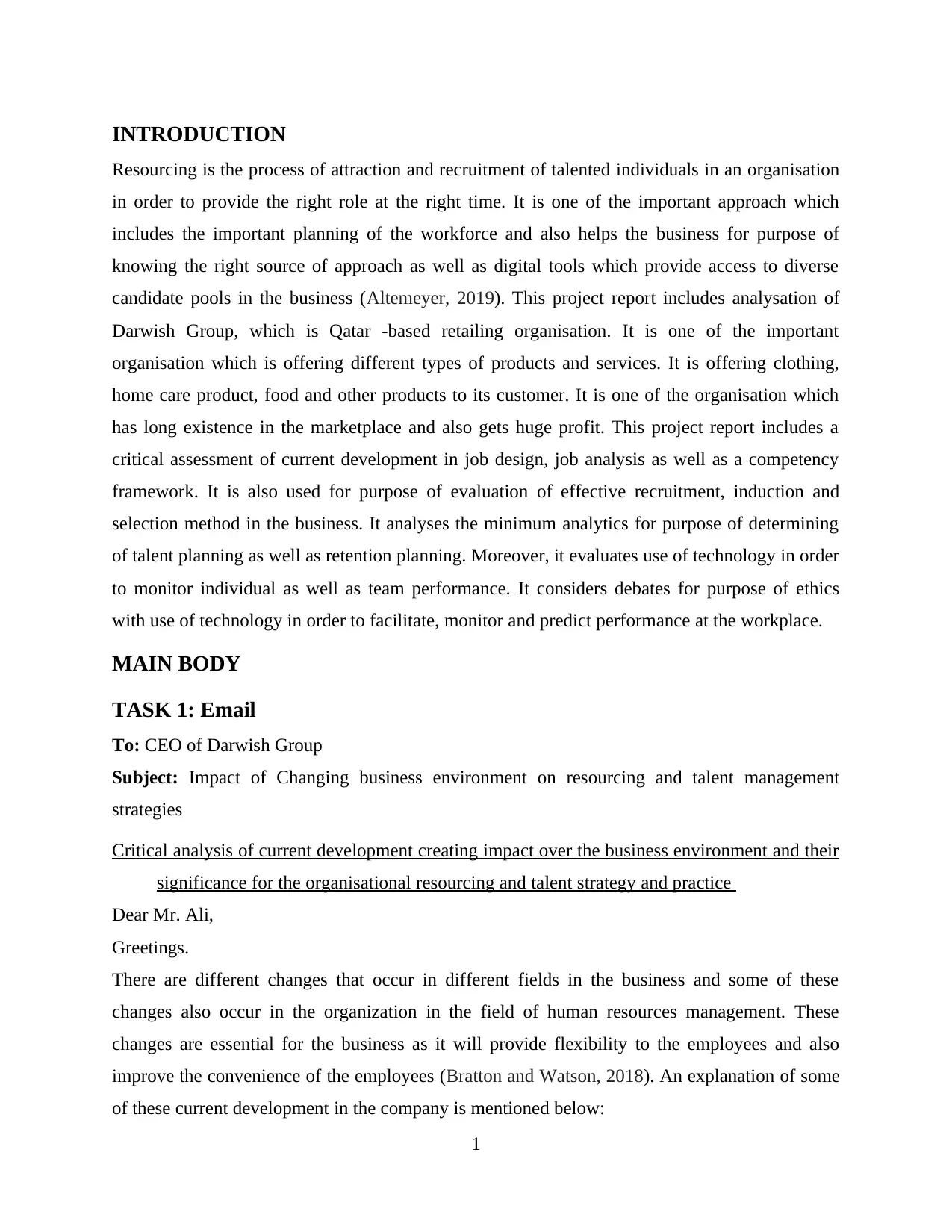
INTRODUCTION
Resourcing is the process of attraction and recruitment of talented individuals in an organisation
in order to provide the right role at the right time. It is one of the important approach which
includes the important planning of the workforce and also helps the business for purpose of
knowing the right source of approach as well as digital tools which provide access to diverse
candidate pools in the business (Altemeyer, 2019). This project report includes analysation of
Darwish Group, which is Qatar -based retailing organisation. It is one of the important
organisation which is offering different types of products and services. It is offering clothing,
home care product, food and other products to its customer. It is one of the organisation which
has long existence in the marketplace and also gets huge profit. This project report includes a
critical assessment of current development in job design, job analysis as well as a competency
framework. It is also used for purpose of evaluation of effective recruitment, induction and
selection method in the business. It analyses the minimum analytics for purpose of determining
of talent planning as well as retention planning. Moreover, it evaluates use of technology in order
to monitor individual as well as team performance. It considers debates for purpose of ethics
with use of technology in order to facilitate, monitor and predict performance at the workplace.
MAIN BODY
TASK 1: Email
To: CEO of Darwish Group
Subject: Impact of Changing business environment on resourcing and talent management
strategies
Critical analysis of current development creating impact over the business environment and their
significance for the organisational resourcing and talent strategy and practice
Dear Mr. Ali,
Greetings.
There are different changes that occur in different fields in the business and some of these
changes also occur in the organization in the field of human resources management. These
changes are essential for the business as it will provide flexibility to the employees and also
improve the convenience of the employees (Bratton and Watson, 2018). An explanation of some
of these current development in the company is mentioned below:
1
Resourcing is the process of attraction and recruitment of talented individuals in an organisation
in order to provide the right role at the right time. It is one of the important approach which
includes the important planning of the workforce and also helps the business for purpose of
knowing the right source of approach as well as digital tools which provide access to diverse
candidate pools in the business (Altemeyer, 2019). This project report includes analysation of
Darwish Group, which is Qatar -based retailing organisation. It is one of the important
organisation which is offering different types of products and services. It is offering clothing,
home care product, food and other products to its customer. It is one of the organisation which
has long existence in the marketplace and also gets huge profit. This project report includes a
critical assessment of current development in job design, job analysis as well as a competency
framework. It is also used for purpose of evaluation of effective recruitment, induction and
selection method in the business. It analyses the minimum analytics for purpose of determining
of talent planning as well as retention planning. Moreover, it evaluates use of technology in order
to monitor individual as well as team performance. It considers debates for purpose of ethics
with use of technology in order to facilitate, monitor and predict performance at the workplace.
MAIN BODY
TASK 1: Email
To: CEO of Darwish Group
Subject: Impact of Changing business environment on resourcing and talent management
strategies
Critical analysis of current development creating impact over the business environment and their
significance for the organisational resourcing and talent strategy and practice
Dear Mr. Ali,
Greetings.
There are different changes that occur in different fields in the business and some of these
changes also occur in the organization in the field of human resources management. These
changes are essential for the business as it will provide flexibility to the employees and also
improve the convenience of the employees (Bratton and Watson, 2018). An explanation of some
of these current development in the company is mentioned below:
1
⊘ This is a preview!⊘
Do you want full access?
Subscribe today to unlock all pages.

Trusted by 1+ million students worldwide

Workforce diversity: It is one of the most important part of the development in the field
of human resource management. Diversity comes with the difference as all the employees
are different from each other in different content like sex, values, cultural norms, race,
age and other things. It is creating an impact over the business environment as some of
these things are creating challenges for the business. This diversity sometimes results in
conflict in the workplace and does not allow different members to communicate in an
effective manner.
Technological and economic changes: There are different changes in the occupational
pattern of people due to globalisation and other components (Chen, Lee and Ahlstrom,
2021). It will make the organisation more automated and also results in improving the
efficiency of the business but at the same time, it will increase the requirement of training
and development in the business.
Work flexibility: This is the requirement of the business for a different purpose. Work
flesibility creates an impact on the business environment. It does not allow them to make
employees to come to the organisation on time instead due to this, employees prefer to
work from home.
All these current developments create vast changes for the business environment but at the
same time, it is also creating significance for the organisational resourcing and talent strategy.
These are different positive impacts of these factors on the business. An explanation of some of
the significance of the company is mentioned below:
Improve satisfaction: Work flexibility is one of the important components of the
business as it allows employees to work from home and also provides them time
flexibility for the company. It is important for purpose of satisfaction of the employees
with the company. It is important for the company for purpose of giving extra benefits to
the employees and also enable the business for purpose of retaining the employees for the
long term (D’Annunzio-Green, 2018).
Improve the efficiency: An organization is also making an efforts of implementing
different technological changes in their business, which is important for the purpose of
improving their efficacy. Business needs to provide proper training and development to
the employees which enable them to improve their skills, knowledge and other
capabilities.
2
of human resource management. Diversity comes with the difference as all the employees
are different from each other in different content like sex, values, cultural norms, race,
age and other things. It is creating an impact over the business environment as some of
these things are creating challenges for the business. This diversity sometimes results in
conflict in the workplace and does not allow different members to communicate in an
effective manner.
Technological and economic changes: There are different changes in the occupational
pattern of people due to globalisation and other components (Chen, Lee and Ahlstrom,
2021). It will make the organisation more automated and also results in improving the
efficiency of the business but at the same time, it will increase the requirement of training
and development in the business.
Work flexibility: This is the requirement of the business for a different purpose. Work
flesibility creates an impact on the business environment. It does not allow them to make
employees to come to the organisation on time instead due to this, employees prefer to
work from home.
All these current developments create vast changes for the business environment but at the
same time, it is also creating significance for the organisational resourcing and talent strategy.
These are different positive impacts of these factors on the business. An explanation of some of
the significance of the company is mentioned below:
Improve satisfaction: Work flexibility is one of the important components of the
business as it allows employees to work from home and also provides them time
flexibility for the company. It is important for purpose of satisfaction of the employees
with the company. It is important for the company for purpose of giving extra benefits to
the employees and also enable the business for purpose of retaining the employees for the
long term (D’Annunzio-Green, 2018).
Improve the efficiency: An organization is also making an efforts of implementing
different technological changes in their business, which is important for the purpose of
improving their efficacy. Business needs to provide proper training and development to
the employees which enable them to improve their skills, knowledge and other
capabilities.
2
Paraphrase This Document
Need a fresh take? Get an instant paraphrase of this document with our AI Paraphraser
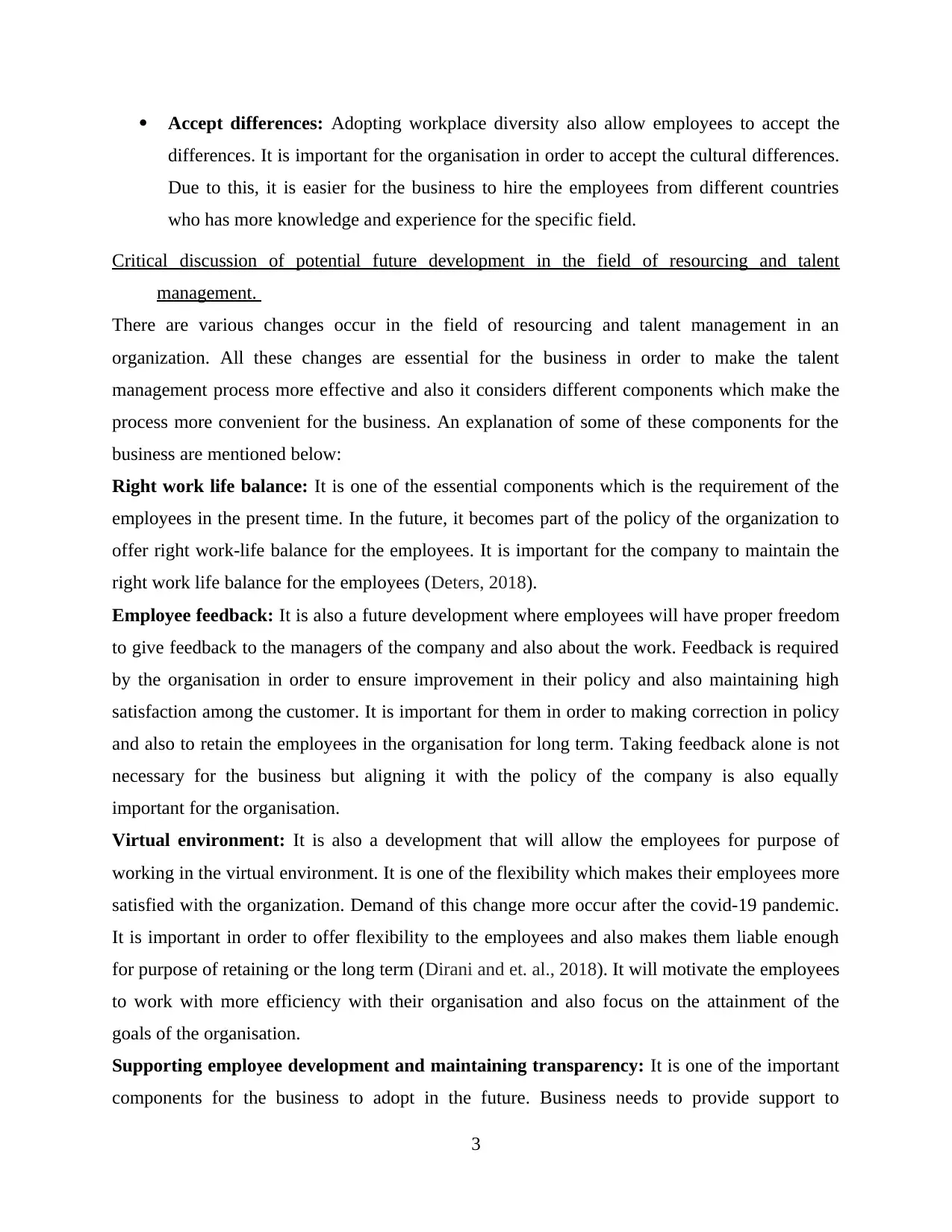
Accept differences: Adopting workplace diversity also allow employees to accept the
differences. It is important for the organisation in order to accept the cultural differences.
Due to this, it is easier for the business to hire the employees from different countries
who has more knowledge and experience for the specific field.
Critical discussion of potential future development in the field of resourcing and talent
management.
There are various changes occur in the field of resourcing and talent management in an
organization. All these changes are essential for the business in order to make the talent
management process more effective and also it considers different components which make the
process more convenient for the business. An explanation of some of these components for the
business are mentioned below:
Right work life balance: It is one of the essential components which is the requirement of the
employees in the present time. In the future, it becomes part of the policy of the organization to
offer right work-life balance for the employees. It is important for the company to maintain the
right work life balance for the employees (Deters, 2018).
Employee feedback: It is also a future development where employees will have proper freedom
to give feedback to the managers of the company and also about the work. Feedback is required
by the organisation in order to ensure improvement in their policy and also maintaining high
satisfaction among the customer. It is important for them in order to making correction in policy
and also to retain the employees in the organisation for long term. Taking feedback alone is not
necessary for the business but aligning it with the policy of the company is also equally
important for the organisation.
Virtual environment: It is also a development that will allow the employees for purpose of
working in the virtual environment. It is one of the flexibility which makes their employees more
satisfied with the organization. Demand of this change more occur after the covid-19 pandemic.
It is important in order to offer flexibility to the employees and also makes them liable enough
for purpose of retaining or the long term (Dirani and et. al., 2018). It will motivate the employees
to work with more efficiency with their organisation and also focus on the attainment of the
goals of the organisation.
Supporting employee development and maintaining transparency: It is one of the important
components for the business to adopt in the future. Business needs to provide support to
3
differences. It is important for the organisation in order to accept the cultural differences.
Due to this, it is easier for the business to hire the employees from different countries
who has more knowledge and experience for the specific field.
Critical discussion of potential future development in the field of resourcing and talent
management.
There are various changes occur in the field of resourcing and talent management in an
organization. All these changes are essential for the business in order to make the talent
management process more effective and also it considers different components which make the
process more convenient for the business. An explanation of some of these components for the
business are mentioned below:
Right work life balance: It is one of the essential components which is the requirement of the
employees in the present time. In the future, it becomes part of the policy of the organization to
offer right work-life balance for the employees. It is important for the company to maintain the
right work life balance for the employees (Deters, 2018).
Employee feedback: It is also a future development where employees will have proper freedom
to give feedback to the managers of the company and also about the work. Feedback is required
by the organisation in order to ensure improvement in their policy and also maintaining high
satisfaction among the customer. It is important for them in order to making correction in policy
and also to retain the employees in the organisation for long term. Taking feedback alone is not
necessary for the business but aligning it with the policy of the company is also equally
important for the organisation.
Virtual environment: It is also a development that will allow the employees for purpose of
working in the virtual environment. It is one of the flexibility which makes their employees more
satisfied with the organization. Demand of this change more occur after the covid-19 pandemic.
It is important in order to offer flexibility to the employees and also makes them liable enough
for purpose of retaining or the long term (Dirani and et. al., 2018). It will motivate the employees
to work with more efficiency with their organisation and also focus on the attainment of the
goals of the organisation.
Supporting employee development and maintaining transparency: It is one of the important
components for the business to adopt in the future. Business needs to provide support to
3

employee development which will allow them to manage the talent in the workplace and also to
attract new diverse and talented employees to their organisation. It is also important for the
business to maintain transparency in their organisation for purpose of sharing and including
employees in important decision making of the company.
Kindly find the below briefing paper. Should you need any further information, please let me
know.
Nicest Regards.
Deepshikha
TASK 2
Research and critical assessment of current development of the job analysis, competency
framework and job design. Evaluation of effective recruitment, selection as well as
induction methods in the organization.
Job analysis can be described as a systematic process for purpose of collecting information
related to a specific job like skill requirements, responsibilities, roles as well as processes for
creating a valid job description. It is one of the analyses which allows business managers of
Darwish Group for purpose of giving them an overview of emotional, physical as well as related
types of qualities of humans for the execution of a job. Job design can be described as the
process which outlines the duties, tasks, methods, relationships, responsibilities and
qualifications for the specific Job (Hongal and Kinange, 2020). It is one of the important tasks
that include different tasks and also includes interaction among the pattern of employees for
purpose of satisfying the needs of the organization. There are different types of development and
changes that take place in the context of job design and analysis. Explanations of these
developments in the context of Darwish Group are mentioned below:
Flexible work schedules: Flexibility in the work schedule can be described as an arrangement as
well as a schedule that takes place from the traditional working day as well as week. It provides
flexibility to the employees for selection of different work schedules which enables them to meet
the needs of personal as well as family. It is one of the important considerations in Darwish
Group.
Pros: This flexible work schedule term provides different benefits for employers as it helps them
to create motivation among the employees (Kamel, 2019). It enables the company for purpose of
4
attract new diverse and talented employees to their organisation. It is also important for the
business to maintain transparency in their organisation for purpose of sharing and including
employees in important decision making of the company.
Kindly find the below briefing paper. Should you need any further information, please let me
know.
Nicest Regards.
Deepshikha
TASK 2
Research and critical assessment of current development of the job analysis, competency
framework and job design. Evaluation of effective recruitment, selection as well as
induction methods in the organization.
Job analysis can be described as a systematic process for purpose of collecting information
related to a specific job like skill requirements, responsibilities, roles as well as processes for
creating a valid job description. It is one of the analyses which allows business managers of
Darwish Group for purpose of giving them an overview of emotional, physical as well as related
types of qualities of humans for the execution of a job. Job design can be described as the
process which outlines the duties, tasks, methods, relationships, responsibilities and
qualifications for the specific Job (Hongal and Kinange, 2020). It is one of the important tasks
that include different tasks and also includes interaction among the pattern of employees for
purpose of satisfying the needs of the organization. There are different types of development and
changes that take place in the context of job design and analysis. Explanations of these
developments in the context of Darwish Group are mentioned below:
Flexible work schedules: Flexibility in the work schedule can be described as an arrangement as
well as a schedule that takes place from the traditional working day as well as week. It provides
flexibility to the employees for selection of different work schedules which enables them to meet
the needs of personal as well as family. It is one of the important considerations in Darwish
Group.
Pros: This flexible work schedule term provides different benefits for employers as it helps them
to create motivation among the employees (Kamel, 2019). It enables the company for purpose of
4
⊘ This is a preview!⊘
Do you want full access?
Subscribe today to unlock all pages.

Trusted by 1+ million students worldwide
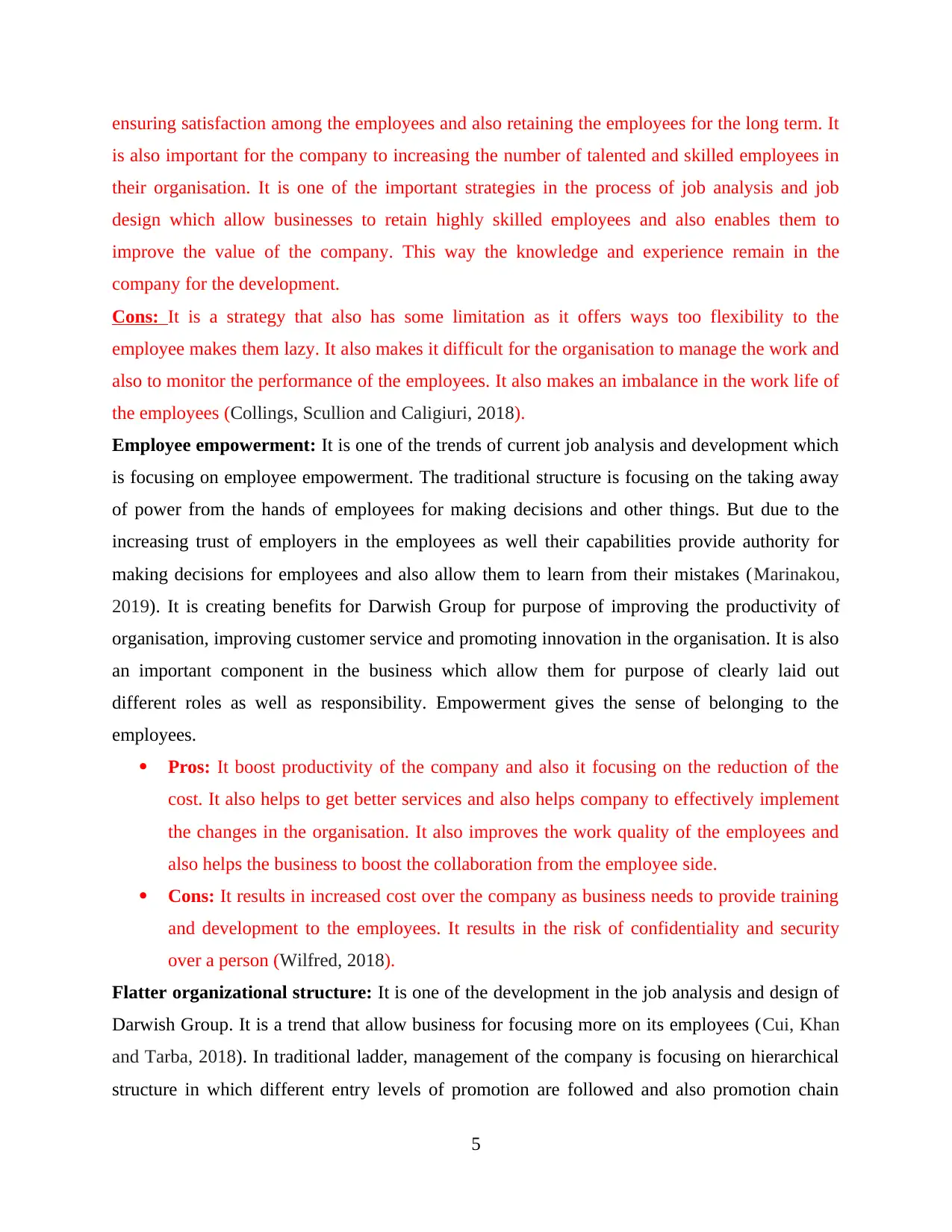
ensuring satisfaction among the employees and also retaining the employees for the long term. It
is also important for the company to increasing the number of talented and skilled employees in
their organisation. It is one of the important strategies in the process of job analysis and job
design which allow businesses to retain highly skilled employees and also enables them to
improve the value of the company. This way the knowledge and experience remain in the
company for the development.
Cons: It is a strategy that also has some limitation as it offers ways too flexibility to the
employee makes them lazy. It also makes it difficult for the organisation to manage the work and
also to monitor the performance of the employees. It also makes an imbalance in the work life of
the employees (Collings, Scullion and Caligiuri, 2018).
Employee empowerment: It is one of the trends of current job analysis and development which
is focusing on employee empowerment. The traditional structure is focusing on the taking away
of power from the hands of employees for making decisions and other things. But due to the
increasing trust of employers in the employees as well their capabilities provide authority for
making decisions for employees and also allow them to learn from their mistakes (Marinakou,
2019). It is creating benefits for Darwish Group for purpose of improving the productivity of
organisation, improving customer service and promoting innovation in the organisation. It is also
an important component in the business which allow them for purpose of clearly laid out
different roles as well as responsibility. Empowerment gives the sense of belonging to the
employees.
Pros: It boost productivity of the company and also it focusing on the reduction of the
cost. It also helps to get better services and also helps company to effectively implement
the changes in the organisation. It also improves the work quality of the employees and
also helps the business to boost the collaboration from the employee side.
Cons: It results in increased cost over the company as business needs to provide training
and development to the employees. It results in the risk of confidentiality and security
over a person (Wilfred, 2018).
Flatter organizational structure: It is one of the development in the job analysis and design of
Darwish Group. It is a trend that allow business for focusing more on its employees (Cui, Khan
and Tarba, 2018). In traditional ladder, management of the company is focusing on hierarchical
structure in which different entry levels of promotion are followed and also promotion chain
5
is also important for the company to increasing the number of talented and skilled employees in
their organisation. It is one of the important strategies in the process of job analysis and job
design which allow businesses to retain highly skilled employees and also enables them to
improve the value of the company. This way the knowledge and experience remain in the
company for the development.
Cons: It is a strategy that also has some limitation as it offers ways too flexibility to the
employee makes them lazy. It also makes it difficult for the organisation to manage the work and
also to monitor the performance of the employees. It also makes an imbalance in the work life of
the employees (Collings, Scullion and Caligiuri, 2018).
Employee empowerment: It is one of the trends of current job analysis and development which
is focusing on employee empowerment. The traditional structure is focusing on the taking away
of power from the hands of employees for making decisions and other things. But due to the
increasing trust of employers in the employees as well their capabilities provide authority for
making decisions for employees and also allow them to learn from their mistakes (Marinakou,
2019). It is creating benefits for Darwish Group for purpose of improving the productivity of
organisation, improving customer service and promoting innovation in the organisation. It is also
an important component in the business which allow them for purpose of clearly laid out
different roles as well as responsibility. Empowerment gives the sense of belonging to the
employees.
Pros: It boost productivity of the company and also it focusing on the reduction of the
cost. It also helps to get better services and also helps company to effectively implement
the changes in the organisation. It also improves the work quality of the employees and
also helps the business to boost the collaboration from the employee side.
Cons: It results in increased cost over the company as business needs to provide training
and development to the employees. It results in the risk of confidentiality and security
over a person (Wilfred, 2018).
Flatter organizational structure: It is one of the development in the job analysis and design of
Darwish Group. It is a trend that allow business for focusing more on its employees (Cui, Khan
and Tarba, 2018). In traditional ladder, management of the company is focusing on hierarchical
structure in which different entry levels of promotion are followed and also promotion chain
5
Paraphrase This Document
Need a fresh take? Get an instant paraphrase of this document with our AI Paraphraser
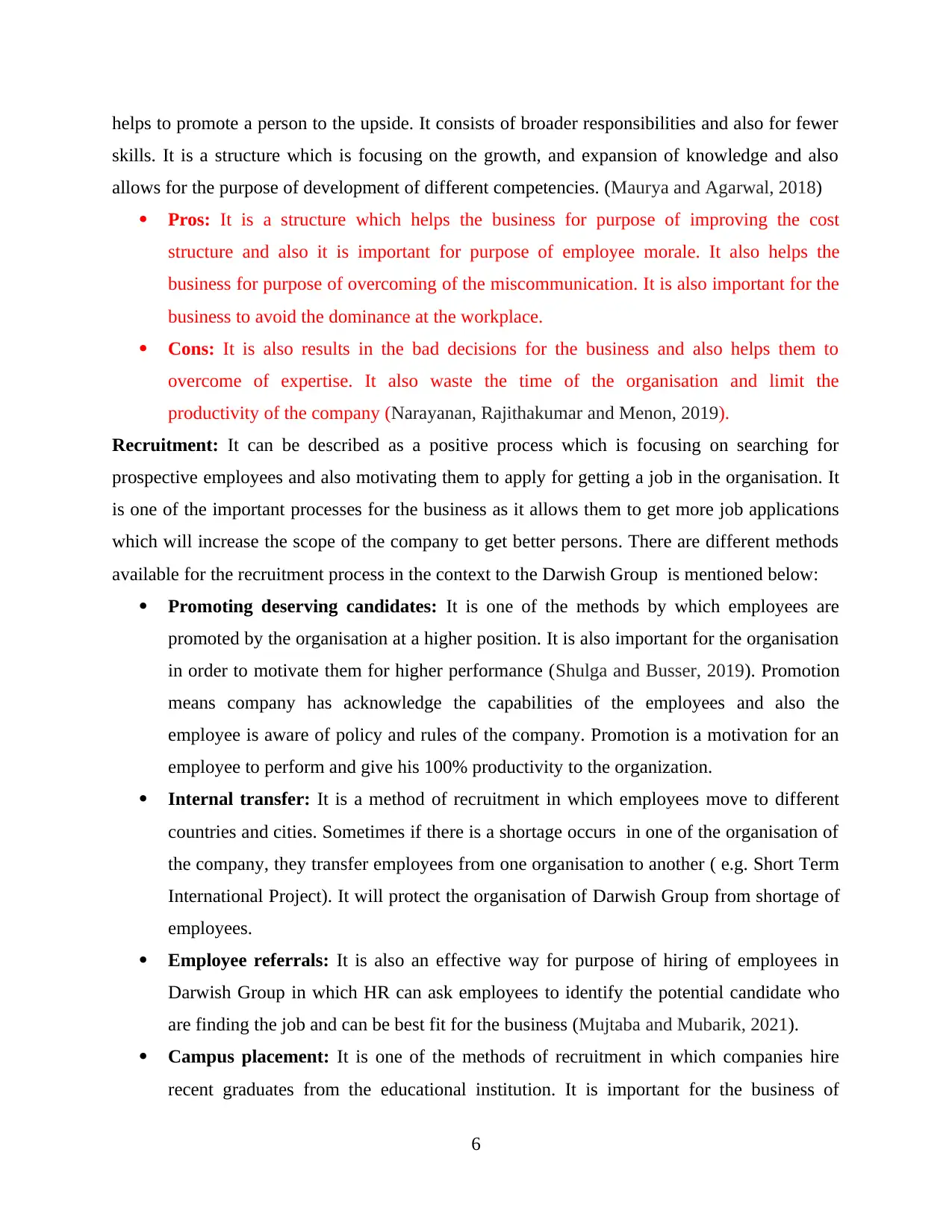
helps to promote a person to the upside. It consists of broader responsibilities and also for fewer
skills. It is a structure which is focusing on the growth, and expansion of knowledge and also
allows for the purpose of development of different competencies. (Maurya and Agarwal, 2018)
Pros: It is a structure which helps the business for purpose of improving the cost
structure and also it is important for purpose of employee morale. It also helps the
business for purpose of overcoming of the miscommunication. It is also important for the
business to avoid the dominance at the workplace.
Cons: It is also results in the bad decisions for the business and also helps them to
overcome of expertise. It also waste the time of the organisation and limit the
productivity of the company (Narayanan, Rajithakumar and Menon, 2019).
Recruitment: It can be described as a positive process which is focusing on searching for
prospective employees and also motivating them to apply for getting a job in the organisation. It
is one of the important processes for the business as it allows them to get more job applications
which will increase the scope of the company to get better persons. There are different methods
available for the recruitment process in the context to the Darwish Group is mentioned below:
Promoting deserving candidates: It is one of the methods by which employees are
promoted by the organisation at a higher position. It is also important for the organisation
in order to motivate them for higher performance (Shulga and Busser, 2019). Promotion
means company has acknowledge the capabilities of the employees and also the
employee is aware of policy and rules of the company. Promotion is a motivation for an
employee to perform and give his 100% productivity to the organization.
Internal transfer: It is a method of recruitment in which employees move to different
countries and cities. Sometimes if there is a shortage occurs in one of the organisation of
the company, they transfer employees from one organisation to another ( e.g. Short Term
International Project). It will protect the organisation of Darwish Group from shortage of
employees.
Employee referrals: It is also an effective way for purpose of hiring of employees in
Darwish Group in which HR can ask employees to identify the potential candidate who
are finding the job and can be best fit for the business (Mujtaba and Mubarik, 2021).
Campus placement: It is one of the methods of recruitment in which companies hire
recent graduates from the educational institution. It is important for the business of
6
skills. It is a structure which is focusing on the growth, and expansion of knowledge and also
allows for the purpose of development of different competencies. (Maurya and Agarwal, 2018)
Pros: It is a structure which helps the business for purpose of improving the cost
structure and also it is important for purpose of employee morale. It also helps the
business for purpose of overcoming of the miscommunication. It is also important for the
business to avoid the dominance at the workplace.
Cons: It is also results in the bad decisions for the business and also helps them to
overcome of expertise. It also waste the time of the organisation and limit the
productivity of the company (Narayanan, Rajithakumar and Menon, 2019).
Recruitment: It can be described as a positive process which is focusing on searching for
prospective employees and also motivating them to apply for getting a job in the organisation. It
is one of the important processes for the business as it allows them to get more job applications
which will increase the scope of the company to get better persons. There are different methods
available for the recruitment process in the context to the Darwish Group is mentioned below:
Promoting deserving candidates: It is one of the methods by which employees are
promoted by the organisation at a higher position. It is also important for the organisation
in order to motivate them for higher performance (Shulga and Busser, 2019). Promotion
means company has acknowledge the capabilities of the employees and also the
employee is aware of policy and rules of the company. Promotion is a motivation for an
employee to perform and give his 100% productivity to the organization.
Internal transfer: It is a method of recruitment in which employees move to different
countries and cities. Sometimes if there is a shortage occurs in one of the organisation of
the company, they transfer employees from one organisation to another ( e.g. Short Term
International Project). It will protect the organisation of Darwish Group from shortage of
employees.
Employee referrals: It is also an effective way for purpose of hiring of employees in
Darwish Group in which HR can ask employees to identify the potential candidate who
are finding the job and can be best fit for the business (Mujtaba and Mubarik, 2021).
Campus placement: It is one of the methods of recruitment in which companies hire
recent graduates from the educational institution. It is important for the business of
6
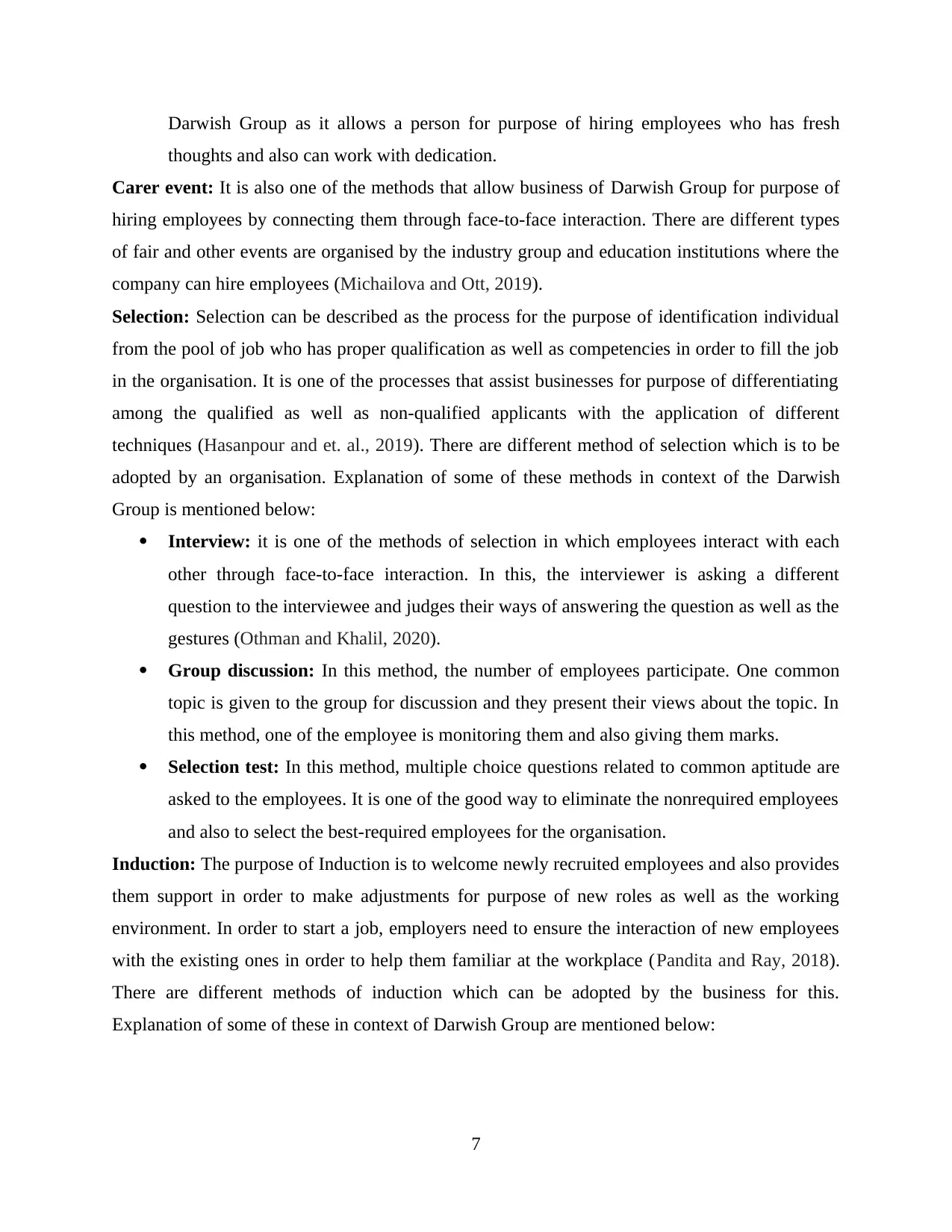
Darwish Group as it allows a person for purpose of hiring employees who has fresh
thoughts and also can work with dedication.
Carer event: It is also one of the methods that allow business of Darwish Group for purpose of
hiring employees by connecting them through face-to-face interaction. There are different types
of fair and other events are organised by the industry group and education institutions where the
company can hire employees (Michailova and Ott, 2019).
Selection: Selection can be described as the process for the purpose of identification individual
from the pool of job who has proper qualification as well as competencies in order to fill the job
in the organisation. It is one of the processes that assist businesses for purpose of differentiating
among the qualified as well as non-qualified applicants with the application of different
techniques (Hasanpour and et. al., 2019). There are different method of selection which is to be
adopted by an organisation. Explanation of some of these methods in context of the Darwish
Group is mentioned below:
Interview: it is one of the methods of selection in which employees interact with each
other through face-to-face interaction. In this, the interviewer is asking a different
question to the interviewee and judges their ways of answering the question as well as the
gestures (Othman and Khalil, 2020).
Group discussion: In this method, the number of employees participate. One common
topic is given to the group for discussion and they present their views about the topic. In
this method, one of the employee is monitoring them and also giving them marks.
Selection test: In this method, multiple choice questions related to common aptitude are
asked to the employees. It is one of the good way to eliminate the nonrequired employees
and also to select the best-required employees for the organisation.
Induction: The purpose of Induction is to welcome newly recruited employees and also provides
them support in order to make adjustments for purpose of new roles as well as the working
environment. In order to start a job, employers need to ensure the interaction of new employees
with the existing ones in order to help them familiar at the workplace (Pandita and Ray, 2018).
There are different methods of induction which can be adopted by the business for this.
Explanation of some of these in context of Darwish Group are mentioned below:
7
thoughts and also can work with dedication.
Carer event: It is also one of the methods that allow business of Darwish Group for purpose of
hiring employees by connecting them through face-to-face interaction. There are different types
of fair and other events are organised by the industry group and education institutions where the
company can hire employees (Michailova and Ott, 2019).
Selection: Selection can be described as the process for the purpose of identification individual
from the pool of job who has proper qualification as well as competencies in order to fill the job
in the organisation. It is one of the processes that assist businesses for purpose of differentiating
among the qualified as well as non-qualified applicants with the application of different
techniques (Hasanpour and et. al., 2019). There are different method of selection which is to be
adopted by an organisation. Explanation of some of these methods in context of the Darwish
Group is mentioned below:
Interview: it is one of the methods of selection in which employees interact with each
other through face-to-face interaction. In this, the interviewer is asking a different
question to the interviewee and judges their ways of answering the question as well as the
gestures (Othman and Khalil, 2020).
Group discussion: In this method, the number of employees participate. One common
topic is given to the group for discussion and they present their views about the topic. In
this method, one of the employee is monitoring them and also giving them marks.
Selection test: In this method, multiple choice questions related to common aptitude are
asked to the employees. It is one of the good way to eliminate the nonrequired employees
and also to select the best-required employees for the organisation.
Induction: The purpose of Induction is to welcome newly recruited employees and also provides
them support in order to make adjustments for purpose of new roles as well as the working
environment. In order to start a job, employers need to ensure the interaction of new employees
with the existing ones in order to help them familiar at the workplace (Pandita and Ray, 2018).
There are different methods of induction which can be adopted by the business for this.
Explanation of some of these in context of Darwish Group are mentioned below:
7
⊘ This is a preview!⊘
Do you want full access?
Subscribe today to unlock all pages.

Trusted by 1+ million students worldwide
1 out of 19
Related Documents
Your All-in-One AI-Powered Toolkit for Academic Success.
+13062052269
info@desklib.com
Available 24*7 on WhatsApp / Email
![[object Object]](/_next/static/media/star-bottom.7253800d.svg)
Unlock your academic potential
Copyright © 2020–2025 A2Z Services. All Rights Reserved. Developed and managed by ZUCOL.





